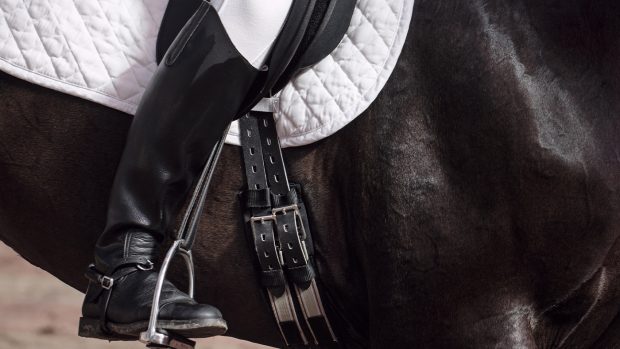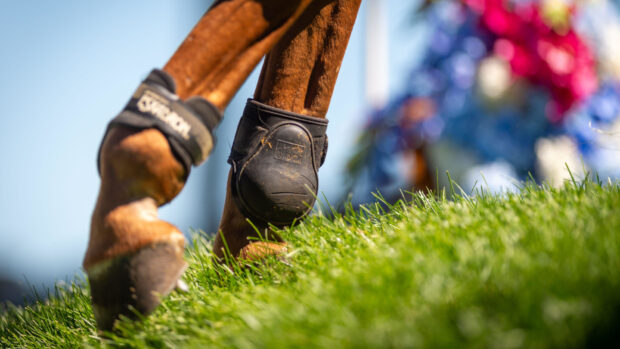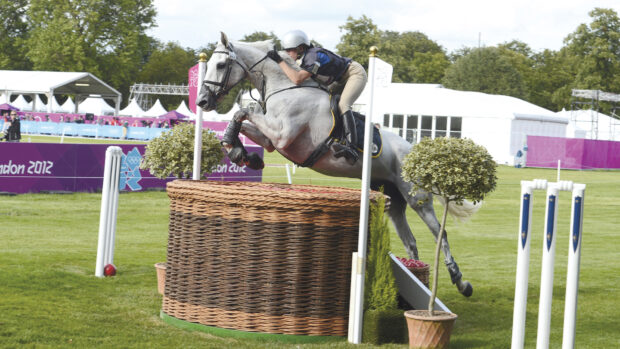Many event horses wear an eventing breastplate for work, particularly when they are jumping at home or in competitions. Riders may choose to use a breastplate for a number of reasons, including most obviously to ensure the saddle does not slip back, and there are many different sorts on the market.
Five-star rider and former young rider team gold medallist Charlotte Agnew says: “I try and use as little tack as possible as a rule, starting with the bare bones and working up depending on what’s needed.
“On the whole I wouldn’t use a breastplate at home, but I would always use one to compete. There are so many random things that can and do go wrong so it feels wise to prevent a saddle slip.”
Charlotte uses a few different types of eventing breastplate. At home, she occasionally puts on an elastic breastgirth – which has a wide piece of elastic which goes round the horse’s chest, from the girth on each side, and a strap over the top of the withers – “to stop a saddle slipping back on a horse with a big front”. She will keep this on for these horses at events.
For competitions, she mostly picks a five-point breastplate, which has attachments at the D-rings, the sides of the girth and under the tummy.

Charlotte Agnew riding Ballingowan Serenity in a five-point breastplate
“In theory a five-point breastplate seems the most practical for dispersing the pressure, and it has an easy and effective martingale attachment,” she says. “I have a couple of horses that I never use a martingale on and I have a Fairfax breastplate for them.”
The Fairfax breastplate has a yoke round the horse’s chest and attaches at the sides of the girth, with an adjustable strap over the withers.
Five-star rider Alice Pearson is another to use breastgirths, tending to pick the Shepherd’s Breast Girth from one of her sponsor’s, Treehouse Sporting Colours, but also sometimes choosing a leather breastgirth.
“I was brought up in a racing background so I’ve always been a fan of the elasticated breastgirths,” she says. “I find they have some stretch so they don’t impede the shoulder movement. I like as little on a horse as possible and these are super lightweight too, as well as acting as handy neckstrap in FEI events [for which ‘unattached neckstraps’ are not allowed].”

Alice Pearson riding Jack The Ginger in an elasticated breastgirth
Ensure eventing breastplates fit correctly
Another top-level rider, Ginny Howe, says she always ensures horses have practised in the eventing breastplate they will wear in competition so they are used to how it feels and says horses can have individual preferences, such as her former four-star horse, Eires Rock.
“He was a little rocket, with a big shoulder and big jump,” she says. “He loved his jumping, but if he had a breastplate or martingale that went between his front legs he would hardly jump and if he did he would feel hollow and awkward – he just didn’t like the feeling. He was one horse that needed a martingale, but back then I just had to get on with things without one!
“I am always very conscious of the adjustment that goes between horses’ front legs as a result, as the girls who work for me will confirm – I’m paranoid it’s too tight or too loose! All too often I see these straps done overly tight when the horse is stood still, but they are worse when moving and no allowance is made for when the horse is jumping, particularly on landing or jumping down drops.
“Equally I understand that if they are too loose it can be dangerous – on a number of occasions I’ve seen a stud or shoe get caught in the strap while the horse is jumping. It is very much about finding the balance.”
Ginny adds: “I am lucky that my saddles all fit my horses extremely well, thanks to my sponsors Voltaire Design UK, so I am not dependent on a breastplate for keeping them in place. I tend to use a breastplate as an additional extra for a just-in-case moment and if horses need a martingale.”
Ginny is another to mix and match different types of breastplate, but says she particularly favours the five-point breastplate from Voltaire.
“With built-in elastic, it gives the freedom needed over the fences, is fully adjustable and you can add the martingale attachment,” she says, explaining she uses this on her five-star horse, Undalgo De Windsor.
“Young horse CHF Archie does not need a martingale so he runs in an elastic breastgirth, just in case the saddle slips,” adds Ginny. “Stallion Interlaken W prefers the V-style elastic breastplate with martingale – due to his shape his saddle can sometimes slip back so I find this really works on him.”

Ginny Howe rides Trendy Captain Clover in a V-style elastic breastplate
Ginny also has a story about how an elastic breastgirth helped keep a saddle in place when she was competing her sister’s horse Echo P at Osberton.
“The girth elastic inside the stud girth snapped as I was jumping a fence cross-country,” she explains. “I was extremely lucky as he was wearing an elastic breastgirth which kept my saddle in place – that and good balance! – we even continued galloping to the next fence before I realised what had happened.”
Article continues below…
You might also be interested in:
Best comfort headcollars 2020: Horse & Hound’s tester ranks her favourites
Find out which comfort headcollars were awarded H&H Approved status in our independent group test

Does your horse really need a half pad?
Are sheepskin pads that go under a saddle necessary?

Subscribe to Horse & Hound magazine today – and enjoy unlimited website access all year round
Olympian Vittoria Panizzon uses a hunting breastplate – which attaches to the D-rings of the saddle and at the bottom of the girth – on all her horses.
“I like a simple look and want time-efficient tack and minimal weight for the horse to carry,” she says.

Vittoria Panizzon’s ride Chequers Play The Game sports a hunting breastplate
Vittoria’s sponsor Pariani make many types of eventing breastplate and manufacture hers to her specific requirements, including a small elastic insert as she likes the breastplate to have “a little give”. The Italian rider is another to stress the importance of adjusting a breastplate to fit.
“I don’t like breastplates on too tight as I worry about restricting shoulder movement, but equally I am wary they never hang low between the legs as that is dangerous. So I always adjust the buckles between each horse to get the fit I want. I see far too many too tight or completely pointlessly loose, especially when teaching.
“I am looking at ways to evolve the breastplate concept and Pariani are working with me to get new ideas. I like models that don’t go between the legs, but I like to be able to clip on a martingale attachment.
“In dire emergency the bridge strap over the withers on a hunting breastplate has served as a neck strap to hang on to!”
Horse & Hound magazine, out every Thursday, is packed with all the latest news and reports, as well as interviews, specials, nostalgia, vet and training advice. Find out more about getting the magazine delivered to your door every week.




